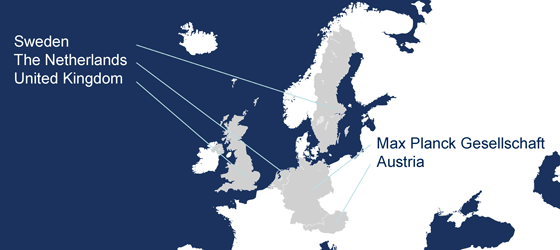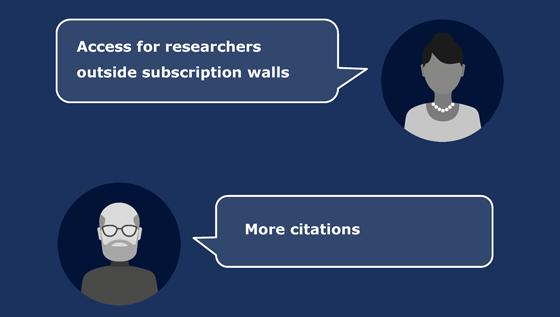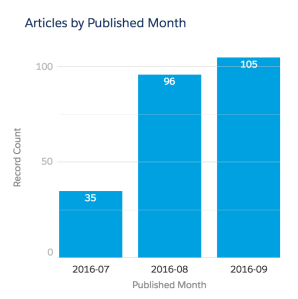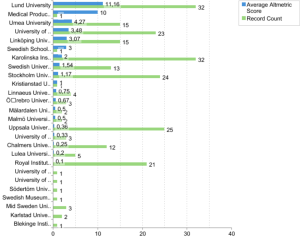In order to fast-forward the shift to Open Access to Swedish research, the universities together with the National Library and the Swedish Research Council will spend approximately €9 000 000 to pay for article publishing charges (APC:s) during two and a half years, from July 2016 to December 2018. Will it be worth it?
The Springer Compact agreement is a deal that combines journal subscription costs with APC:s for 32 Swedish universities during the period. Sweden is not the first country to up, the Netherlands, UK, Austria and Max Planck Society in Germany have already signed this and similar deals. The agreement means that Swedish authors can publish their work with any of 1600 hybrid Open Access journals from Springer, with a CC-BY license. The universities will in total cover the €2200 APC for around 4000 articles by the end of 2018.

Future evaluation of the agreement will compare the Swedish deal with foreign big deals. While there is a widespread concern in Sweden that big deals increase costs on a national level, an evaluation from Birkbeck Centre for Technology and Publishing estimates that the total saving from UK offset agreements is £2.5m in 2015. The Netherlands is soon to renew big deal agreements and has appointed lead advisors for negotiations. Negotiations will focus at target oriented package deals and the national aim of 2024, when all Dutch scientific publications are expected be Open Access. An evaluation committee will later analyze the financial outcome in Sweden.
The following text summarizes a survey on Stockholm University researchers, and the national statistics from July–September according to this new deal.
Author survey results
During the period of measure, July 2016–December 2018, the aim is to have a continuous dialogue with the article authors and their respective universities/institutes. The ambition is to gain deeper knowledge about attitudes toward Open Access and this kind of deals. During the first three months Stockholm University have conducted a survey with 21 respondents (95 % response rate to invitations sent). The result of this survey concludes that Stockholm University researchers:
- are positive to Open Access,
- do not want to administrate APC:s,
- were positively surprised by the agreement,
- are unlikely to choose Open Access when they (personally) have to pay APC,
- are not sure about Open Access mandates from funding agencies,
- are not familiar with CC-BY licence but not negative to it,
- find fast and cost effective publication process to be more important than Open Access.
These first results was presented at the Bibsam meeting in october 2016. From the survey I learned that most of the researchers were not, or weren’t aware of being, obliged publishing with Open Access (73,7%), and that the majority is unfamiliar with the licensing required (84,2%). Very few of the researchers in the survey knew about the Springer Compact deal before we approached them (5,3%). However, their attitudes towards publishing with Open Access were positive, as were they towards this kind of deal with publishers.
What do you think about the university covering the publication fee with this kind of deal?
The respondents were positive to the agreement. They said it was “excellent”, that “it was like a dream”, and suggested us “to continue this license, will save money for publication cost”. A common answer was that this made the process of Open Access publishing easier. One respondent noted that researchers cannot avoid publishing due to save money, and that this deal was helping doing the researchers job. A few argued that no one, researchers nor universities, should have to pay for Open Access.

What’s your argument for publishing Open Access?
“Access, access, access” is a pertinent summary of the respondents’ arguments. They assume Open Access articles have a wider outreach to “especially colleagues outside the subscription walls”, and that this is a wise use of taxpayer’s money; “it’s democratic”. With Open Access the respondents also expect more citations. The only objection against Open Access “is that it is expensive, that many high impact factor journals do not support Open Access, and that there is no funding for Open Access publishing” at the own department.

Impact of publications
During the first 3 months of the agreements, there were 236 articles published (Figure 1: All Springer Compact Articles Published by Month) by 19 of the 32 participating universities in Sweden. This can be compared with in total 157 APC:s in Springer hybrid journals 2015.

The answers in the survey boost the very purpose of Open Access. However, the expected dissemination need to be verified. Researchers want to know about the impact of their work, but have very few tools to do so.
Open Access to publications can be measured. Altmetric is a useful standard to analyze the impact of Open Access through digital footprints: when, where and who is paying attention to my publication? Altmetric combines different types of mentions on the Internet and calculates an Altmetric attention score.
Having the Altmetric goggles on we see 98 of the 236 articles credited with an Altmetric attention score. The figure below (Figure 2) shows the average Altmetric attention score per total number of articles from each institution. Lund University has the highest average number of mentions by article published. The statistics also shows that 25% of the attention comes from United Kingdom and 23% from United states, which proves a high level of international reach for the research presented. Two of the 236 articles have got 1 citation each in Scopus and one of those articles has 1 citation in Web of Science.
More possibilities
The respondents in this limited survey expect that a wider audience will read and cite their articles when published Open Access. The future evaluations of the deal will this into consideration and compare eligible non-OA articles with the Springer Compact articles. We will also continue to analyze the citation metrics as well as the Altmetric data to be able to measure the impact of this open communication of research results in comparison with other publications.
A national Committee will be formed to continue the evaluation of the agreement to provide Swedish universities with better information to prepare for future agreements and strategies. This committee will look at:
- financial consequences of the reallocation of costs from subscriptions to APC:s
- mapping funding grants in relation to published output
- assessment of the usage of publications in comparison with other publications.
- the turn to gold OA from hybrid OA
Given the results from this small survey on a short period of the Springer Compact agreement, it is possible to make a cautious prediction that the most obvious benefits from the agreement this far is that 1) more publications really become Open Access. 2) it is easier for researchers to publish Open Access 3) the APC costs for institutions become predictable 4) the publishing data will be easier to analyse and evaluate. The future evaluation will surely modulate the results and add other perspectives.
Finally, I want to mention that Springer compact agreement is one of many routes to boost Open Access. There are examples without article processing charges, i.e. Open Libraries of Humanities supported by Uppsala University, Stockholm University, the National Library and Riksbankens jubileumsfond.

2 thoughts on “Boosting Open Access – First Evaluation of the Springer Compact agreement in Sweden”